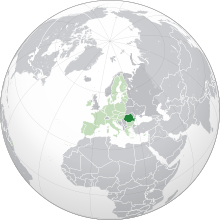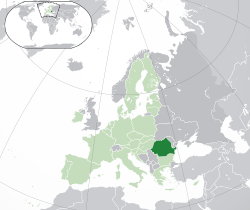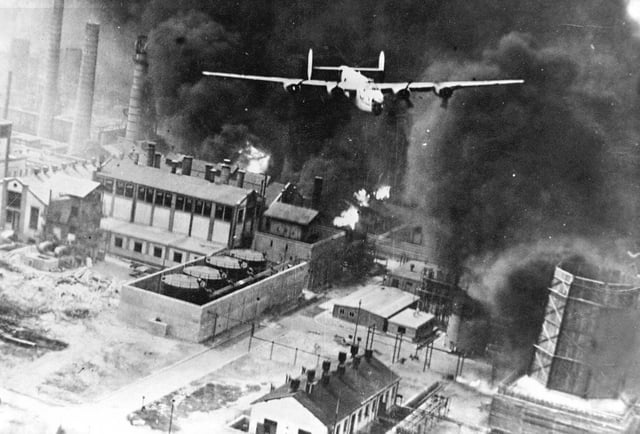Romania

Romania

Romania România(Romanian) | |
|---|---|
Anthem:"Deșteaptă-te, române!" (English:"Awaken thee, Romanian!") | |
Location of Romania (dark green)– in Europe (green & dark grey) – in the European Union (green) – [Legend] | |
| Capital and largest city | Bucharest 44°25′N 26°06′E [471] |
| Official languages | Romanian[5] |
| Recognised minority languages[6] | |
| Ethnic groups (2011[7]) |
|
| Demonym(s) | Romanian |
| Government | Unitary semi-presidential republic |
• President | Klaus Iohannis |
• Prime Minister | Viorica Dăncilă |
| Legislature | Parliament |
• Upper house | Senate |
• Lower house | Chamber of Deputies |
| Establishment history | |
• First Romanian polities | c.895 / 1247a |
• Principality of Wallachia | 1330 |
• Principality of Moldavia | c.1360 |
• Principality of Transylvania | 1570 |
• First common rule under Michael the Brave | 1600 |
• United Principalitiesb | 24 January 1859 |
| 9 May 1877 / 1878c | |
• Kingdom of Romania | 14 March 1881 |
• Greater Romaniad | 1918 / 1920e |
| Area | |
• Total | 238,397 km2(92,046 sq mi) (81st) |
• Water (%) | 3 |
| Population | |
• 2019 estimate | |
• 2011 census | 20,121,641[7] (58th) |
• Density | 84.4/km2(218.6/sq mi) (117th) |
| GDP(PPP) | 2019 estimate |
• Total | $541.807 billion[9] (40th) |
• Per capita | $27,753[9] (54th) |
| GDP(nominal) | 2019 estimate |
• Total | $244.158 billion[9] (46th) |
• Per capita | $12,506[9] (57th) |
| Gini(2018) | medium |
| HDI(2017) | very high · 52nd |
| Currency | Romanian Leu (RON) |
| Time zone | UTC+2(EET) |
• Summer (DST) | UTC+3(EEST) |
| Date format | dd.mm.yyyy (AD) |
| Driving side | right |
| Calling code | +40 |
| ISO 3166 code | RO |
| Internet TLD | .rof |
| |
Romania (/roʊˈmeɪniə/ (listen) ro-MAY-nee-ə; Romanian: România [romɨˈni.a] (listen)) is a country located at the crossroads of Central, Eastern, and Southeastern Europe. It borders the Black Sea to the southeast, Bulgaria to the south, Ukraine to the north, Hungary to the west, Serbia to the southwest, and Moldova to the east. It has a predominantly temperate-continental climate. With a total area of 238,397 square kilometres (92,046 sq mi), Romania is the 12th largest country and also the 7th most populous member state of the European Union, having almost 20 million inhabitants. Its capital and largest city is Bucharest, and other major urban areas include Cluj-Napoca, Timișoara, Iași, Constanța, Craiova, and Brașov.
The River Danube, Europe's second-longest river, rises in Germany's Black Forest and flows in a general southeast direction for 2,857 km (1,775 mi), coursing through ten countries before emptying into Romania's Danube Delta. The Carpathian Mountains, which cross Romania from the north to the southwest, include Moldoveanu Peak, at an altitude of 2,544 m (8,346 ft).[12]
Modern Romania was formed in 1859 through a personal union of the Danubian Principalities of Moldavia and Wallachia. The new state, officially named Romania since 1866, gained independence from the Ottoman Empire in 1877. Following World War I after declaring its neutrality in 1914, when Romania fought on the side of the Allied powers starting with 1916, Bukovina, Bessarabia, Transylvania as well as parts of Banat, Crișana, and Maramureș became part of the sovereign Kingdom of Romania. In June–August 1940, as a consequence of the Molotov–Ribbentrop Pact and Second Vienna Award, Romania was compelled to cede Bessarabia and Northern Bukovina to the Soviet Union, and Northern Transylvania to Hungary. In November 1940, Romania signed the Tripartite Pact and, consequently, in June 1941 entered World War II on the Axis side, fighting against the Soviet Union until August 1944, when it joined the Allies and recovered Northern Transylvania. Following the war, under the occupation of the Red Army's forces, Romania became a socialist republic and member of the Warsaw Pact. After the 1989 Revolution, Romania began a transition towards democracy and a market economy.
Romania ranks 52nd in the Human Development Index,[13] and is a developing country.[14][15] It has the world's 47th largest economy by nominal GDP and an annual economic growth rate of 7% (2017), the highest in the EU at the time.[16] Following rapid economic growth in the early 2000s, Romania has an economy predominantly based on services, and is a producer and net exporter of machines and electric energy, featuring companies like Automobile Dacia and OMV Petrom. It has been a member of the United Nations since 1955, part of NATO since 2004, and part of the European Union since 2007. An overwhelming majority of the population identifies themselves as Eastern Orthodox Christians and are native speakers of Romanian, a Romance language.
Romania România(Romanian) | |
|---|---|
Anthem:"Deșteaptă-te, române!" (English:"Awaken thee, Romanian!") | |
Location of Romania (dark green)– in Europe (green & dark grey) – in the European Union (green) – [Legend] | |
| Capital and largest city | Bucharest 44°25′N 26°06′E [471] |
| Official languages | Romanian[5] |
| Recognised minority languages[6] | |
| Ethnic groups (2011[7]) |
|
| Demonym(s) | Romanian |
| Government | Unitary semi-presidential republic |
• President | Klaus Iohannis |
• Prime Minister | Viorica Dăncilă |
| Legislature | Parliament |
• Upper house | Senate |
• Lower house | Chamber of Deputies |
| Establishment history | |
• First Romanian polities | c.895 / 1247a |
• Principality of Wallachia | 1330 |
• Principality of Moldavia | c.1360 |
• Principality of Transylvania | 1570 |
• First common rule under Michael the Brave | 1600 |
• United Principalitiesb | 24 January 1859 |
| 9 May 1877 / 1878c | |
• Kingdom of Romania | 14 March 1881 |
• Greater Romaniad | 1918 / 1920e |
| Area | |
• Total | 238,397 km2(92,046 sq mi) (81st) |
• Water (%) | 3 |
| Population | |
• 2019 estimate | |
• 2011 census | 20,121,641[7] (58th) |
• Density | 84.4/km2(218.6/sq mi) (117th) |
| GDP(PPP) | 2019 estimate |
• Total | $541.807 billion[9] (40th) |
• Per capita | $27,753[9] (54th) |
| GDP(nominal) | 2019 estimate |
• Total | $244.158 billion[9] (46th) |
• Per capita | $12,506[9] (57th) |
| Gini(2018) | medium |
| HDI(2017) | very high · 52nd |
| Currency | Romanian Leu (RON) |
| Time zone | UTC+2(EET) |
• Summer (DST) | UTC+3(EEST) |
| Date format | dd.mm.yyyy (AD) |
| Driving side | right |
| Calling code | +40 |
| ISO 3166 code | RO |
| Internet TLD | .rof |
| |
Etymology

Neacșu's letter from 1521, the oldest surviving document written in Romanian.
The oldest known surviving document written in Romanian, a 1521 letter known as the "Letter of Neacșu from Câmpulung",[22] is also notable for including the first documented occurrence of the country's name: Wallachia is mentioned as Țeara Rumânească (old spelling for "The Romanian Land"; țeara from the Latin terra, "land"; current spelling: Țara Românească).
Two spelling forms: român and rumân were used interchangeably[1] until sociolinguistic developments in the late 17th century led to semantic differentiation of the two forms: rumân came to mean "bondsman", while român retained the original ethnolinguistic meaning.[23] After the abolition of serfdom in 1746, the word rumân gradually fell out of use and the spelling stabilised to the form român.[2] Tudor Vladimirescu, a revolutionary leader of the early 19th century, used the term Rumânia to refer exclusively to the principality of Wallachia."[24]
In English, the name of the country was formerly spelt Rumania or Roumania.[26] Romania became the predominant spelling around 1975.[27] Romania is also the official English-language spelling used by the Romanian government.[28] A handful of other languages (including Italian, Hungarian, Portuguese, and Norwegian) have also switched to "o" like English, but most languages continue to prefer forms with u, e.g. French Roumanie, German and Swedish Rumänien, Spanish Rumania (the archaic form Rumanía is still in use in Spain), Polish Rumunia, Russian Румыния (Rumyniya), and Japanese ルーマニア (Rūmania).
Official names
1859–1862: United Principalities of Moldavia and Wallachia
1862–1866: Romanian United Principalities or Romania
1866–1881: Romania or Principality of Romania
1881–1947: Kingdom of Romania or Romania
1947–1965: Romanian People's Republic (RPR) or Romania
1965–December, 1989: Socialist Republic of Romania (RSR) or Romania
December, 1989–present: Romania
History
Prehistory and antiquity

Skull from the "Cave with Bones" (the oldest known remain of Homo sapiens in Europe).[29]

Maximum territorial extent of the Kingdom of Dacia during Burebista's reign (early 40s BC.)
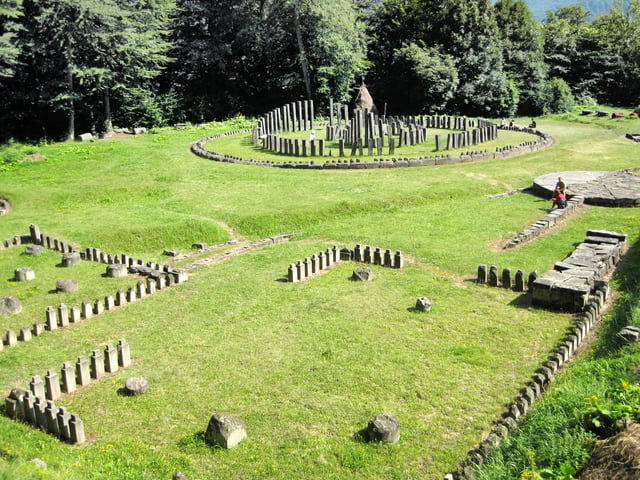
Ruins of sanctuaries at Sarmizegetusa Regia (Dacia's capital during the reigns of Burebista and Decebalus).
Human remains found in Peștera cu Oase ("Cave with Bones"), radiocarbon dated as being from circa 40,000 years ago, represent the oldest known Homo sapiens in Europe.[29] Neolithic techniques and agriculture spread after the arrival of a mixed group of people from Thessaly in the 6th millennium BC.[30][31] Excavations near a salt spring at Lunca yielded the earliest evidence for salt exploitation in Europe; here the production of salt started between 6050 and 5900 BC.[32] The first permanent settlements also appeared in the Neolithic.[33] Some of them developed into "proto-cities",[33] which were larger than 800 acres (3.2 km2).[34][35] The Cucuteni–Trypillia culture—the best known archaeological culture of Old Europe—flourished in Muntenia, southeastern Transylvania and northeastern Moldavia in the 3rd millennium BC.[35] The first fortified settlements appeared around 1800 BC, showing the militant character of Bronze Age societies.[35]
Greek colonies established on the Black Sea coast in the 7th century BC became important centres of commerce with the local tribes.[36][37] Among the native peoples, Herodotus listed the Getae of the Lower Danube region, the Agathyrsi of Transylvania and the Syginnae of the plains along the river Tisza at the beginning of the 5th century BC.[38] Centuries later, Strabo associated the Getae with the Dacians who dominated the lands along the southern Carpathian Mountains in the 1st century BC.[39] Burebista was the first Dacian ruler to unite the local tribes.[39][40] He also conquered the Greek colonies in Dobruja and the neighboring peoples as far as the Middle Danube and the Balkan Mountains between around 55 and 44 BC.[39][41] After Burebista was murdered in 44 BC, his empire collapsed.[39][42]
The Romans reached Dacia during Burebista's reign and conquered Dobruja in 46 AD.[42] Dacia was again united under Decebalus around 85.[39][43] He resisted the Romans for decades, but the Roman army annihilated his troops in 106.[44] Emperor Trajan transformed Banat, Oltenia and the greater part of Transylvania into the new Roman province of Dacia, but Dacian, Germanic and Sarmatian tribes continued to dominate the lands along the Roman frontiers.[45][46] The Romans pursued an organised colonisation policy and the provincials enjoyed a long period of peace and prosperity in the 2nd century.[47][48] Scholars accepting the Daco-Roman continuity theory—one of the main theories about the origin of the Romanians—say that the cohabitation of the native Dacians and the Roman colonists in Roman Dacia was the first phase of the Romanians' ethnogenesis.[49][50]
The Carpians, Goths and other neighboring tribes made regular raids against Dacia from the 210s.[51] The Romans could not resist and Emperor Aurelian ordered the evacuation of the province Dacia Trajana in 271.[52] Scholars supporting the continuity theory are convinced that most Latin-speaking commoners stayed behind when the army and civil administration was withdrawn.[53] The Romans did not abandon their fortresses along the northern banks of the Lower Danube for decades, and Dobruja (known as Scythia Minor) remained an integral part of the Roman Empire until the early 7th century.[49][54]
Middle Ages

Gutthiuda, or the land of the Gothic-speaking Thervingi, and the neighboring tribes (370s AD).

Vlad III of Wallachia (also known as Vlad the Impaler), medieval ruler of Wallachia
The Goths were expanding towards the Lower Danube from the 230s, forcing the native peoples to flee to the Roman Empire or to accept their suzerainty.[55][56][57] The Goths' rule came to an abrupt end when the Huns invaded their territory in 376, causing new waves of migrations.[55][57][58] The Huns forced the remnants of the local population into submission, but their empire collapsed in 454.[55][59] The Gepids took possession of the former Dacia province.[60][61] The nomadic Avars defeated the Gepids and established a powerful empire around 570.[55][62] The Bulgars, who also came from the Eurasian steppes, occupied the Lower Danube region in 680.[55] According to scholars who accept the Daco-Roman continuity theory, the Romanians' ancestors, known by the exonym Vlachs in the Middle Ages, lived in densely forested areas, separated from the Goths, Huns, Gepids and Avars during these centuries.[63]
Place names of Slavic origin abound in Romania, indicating that a numerous Slavic-speaking population used to live in the territory.[64] The first Slavic groups settled in Moldavia and Wallachia in the 6th century,[65] in Transylvania around 600.[66] After the Avar Khaganate collapsed in the 790s, Bulgaria became the dominant power of the region, occupying lands as far as the river Tisa.[55] The Council of Preslav declared Old Church Slavonic the language of liturgy in the First Bulgarian Empire in 893.[67] The Romanians also adopted Old Church Slavonic as their liturgical language.[68]
The Magyars (or Hungarians) took control of the steppes north of the Lower Danube in the 830s, but the Bulgarians and the Pechenegs jointly forced them to abandon this region for the lowlands along the Middle Danube around 894.[69] Centuries later, the Gesta Hungarorum wrote of the invading Magyars' wars against three dukes—Glad, Menumorut and the Vlach Gelou—for Banat, Crișana and Transylvania.[70][71] The Gesta also listed many peoples—Slavs, Bulgarians, Vlachs, Khazars and Székelys—inhabiting the same regions.[72][73] The reliability of the Gesta is debated, with some scholars regarding it as a basically accurate account, others describing it as a literary work filled with invented details.[74][75][76] The lowlands abandoned by the Hungarians to east of the Carpathians were seized by the Pechenegs.[77]
Byzantine missionaries proselytised in the lands east of the Tisa from the 940s[78] and Byzantine troops occupied Dobruja in the 970s.[79] The first king of Hungary, Stephen I, who supported Western European missionaries, defeated the local chieftains and established Roman Catholic bishoprics in Transylvania and Banat in the early 11th century.[80][81] Significant Pecheneg groups fled to the Byzantine Empire in the 1040s; the Oghuz Turks followed them, and the nomadic Cumans became the dominant power of the steppes in the 1060s.[82] Cooperation between the Cumans and the Vlachs against the Byzantine Empire is well documented from the end of the 11th century.[83] Scholars who reject the Daco-Roman continuity theory say that the first Vlach groups left their Balkan homeland for the mountain pastures of the eastern and southern Carpathians in the 11th century, establishing the Romanians' presence in the lands to the north of the Lower Danube.[84]
Exposed to nomadic incursions, Transylvania developed into an important border province of the Kingdom of Hungary.[85][86] The Székelys—a community of free warriors—settled in central Transylvania around 1100, and moved to the easternmost regions around 1200.[87] Colonists from the Holy Roman Empire—the Transylvanian Saxons' ancestors—came to the province in the 1150s.[87][88] A high-ranking royal official, styled voivode, ruled the Transylvanian counties from the 1170s, but the Székely and Saxon seats (or districts) were not subject to the voivodes' authority.[89] Royal charters wrote of the "Vlachs' land" in southern Transylvania in the early 13th century, indicating the existence of autonomous Romanian communities.[90] Papal correspondence mentioned the activities of Orthodox prelates among the Romanians in Muntenia in the 1230s.[91]
The Mongols destroyed large territories during their invasion of Eastern and Central Europe in 1241 and 1242.[92] The Mongols' Golden Horde emerged as the dominant power of Eastern Europe, but Béla IV of Hungary's land grant to the Knights Hospitallers in Oltenia and Muntenia shows that the local Vlach rulers were subject to the king's authority in 1247.[93][94] Basarab I of Wallachia united the Romanian polities between the southern Carpathians and the Lower Danube in the 1310s.[95] He defeated the Hungarian royal army in the Battle of Posada and secured the independence of Wallachia in 1330.[96][97] The second Romanian principality, Moldavia, achieved full autonomy during the reign of Bogdan I around 1360.[97] A local dynasty ruled the Despotate of Dobruja in the second half of the 14th century, but the Ottoman Empire took possession of the territory after 1388.[98]
Princes Mircea I and Vlad III of Wallachia, and Stephen III of Moldavia defended their countries independence against the Ottomans, but most Wallachian and Moldavian princes paid a regular tribute to the Ottoman sultans from 1417 and 1456, respectively.[99][100] A military commander of Romanian origin, John Hunyadi, organised the defence of the Kingdom of Hungary until his death in 1456.[101] Increasing taxes outraged the Transylvanian peasants and they rose up in an open rebellion in 1437, but the Hungarian nobles and the heads of the Saxon and Székely communities jointly pushed their revolt.[102] The formal alliance of the Hungarian, Saxon and Székely leaders, known as the Union of the Three Nations, became an important element of the self-government of Transylvania.[103] The Orthodox Romanian knezes (or chiefs) were excluded from the Union.[103]
Early Modern Times and national awakening
The Kingdom of Hungary collapsed and the Ottomans occupied parts of Banat and Crișana in 1541.[103] Transylvania and Maramureș, along with the rest of Banat and Crișana developed into a new state under Ottoman suzerainty, the Principality of Transylvania.[104] Reformation spread and four denominations—Calvinism, Lutheranism, Unitarianism and Roman Catholicism—were officially acknowledged in 1568.[105] The Romanians' Orthodox faith remained only tolerated,[105] although they made up more than one-third of the population, according to 17th-century estimations.[106][107]
The princes of Transylvania, Wallachia and Moldavia joined the Holy League against the Ottoman Empire in 1594.[108] The Wallachian prince, Michael the Brave, united the three principalities under his rule in May 1600.[109][110] The neighboring powers forced him to abdicate in September, but he became a symbol of the unification of the Romanian lands in the 19th century.[109] Although the rulers of the three principalities continued to pay tribute to the Ottomans, the most talented princes—Gabriel Bethlen of Transylvania, Matei Basarab of Wallachia, and Vasile Lupu of Moldavia—strengthened their autonomy.[111]
The united armies of the Holy League expelled the Ottoman troops from Central Europe between 1684 and 1699 and the Principality of Transylvania was integrated into the Habsburg Monarchy.[112] The Habsburgs supported the Catholic clergy and persuaded the Orthodox Romanian prelates to accept the union with the Roman Catholic Church in 1699.[113] The Church Union strengthened the Romanian intellectuals' devotion to their Roman heritage.[114] The Orthodox Church was restored in Transylvania only after Orthodox monks stirred up revolts in 1744 and 1759.[115] The organization of the Transylvanian Military Frontier caused further disturbances, especially among the Székelys in 1764.[116]
Princes Dimitrie Cantemir of Moldavia and Constantin Brâncoveanu of Wallachia concluded alliances with the Habsburg Monarchy and Russia against the Ottomans, but they were dethroned in 1711 and 1714, respectively.[117] The sultans lost confidence in the native princes and appointed Orthodox merchants from the Phanar district of Istanbul to rule Moldova and Wallachia.[118][119] The Phanariot princes pursued oppressive fiscal policies and dissolved the army.[120] The neighboring powers take advantage of the situation: the Habsburg Monarchy annexed northwestern part of Moldavia, or Bucovina, in 1775, and the Russian Empire seized the eastern half of Moldavia, or Bessarabia, in 1812.[121][122]
A census revealed that the Romanians were more numerous than any of the other ethnic groups in Transylvania in 1733, but legislation continued to use contemptuous adjectives (such as "tolerated" and "admitted") when referring to them.[123][124] The Uniate bishop, Inocențiu Micu-Klein who demanded the recognition of the Romanians as the fourth privileged nation was forced into exile.[125][124] Uniate and Orthodox clerics and laymen jointly signed a plea for the Transylvanian Romanians' emancipation in 1791, but the monarch and the local authorities denied to grant their requests.[126][123]
Independence and monarchy
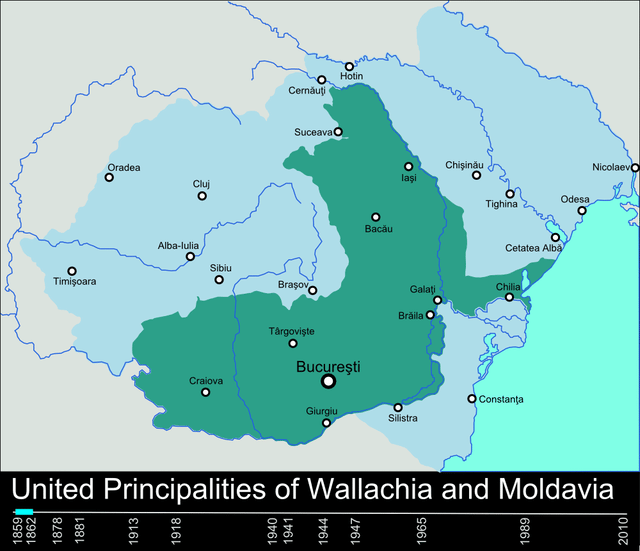
Changes in Romania's territory since 1859.
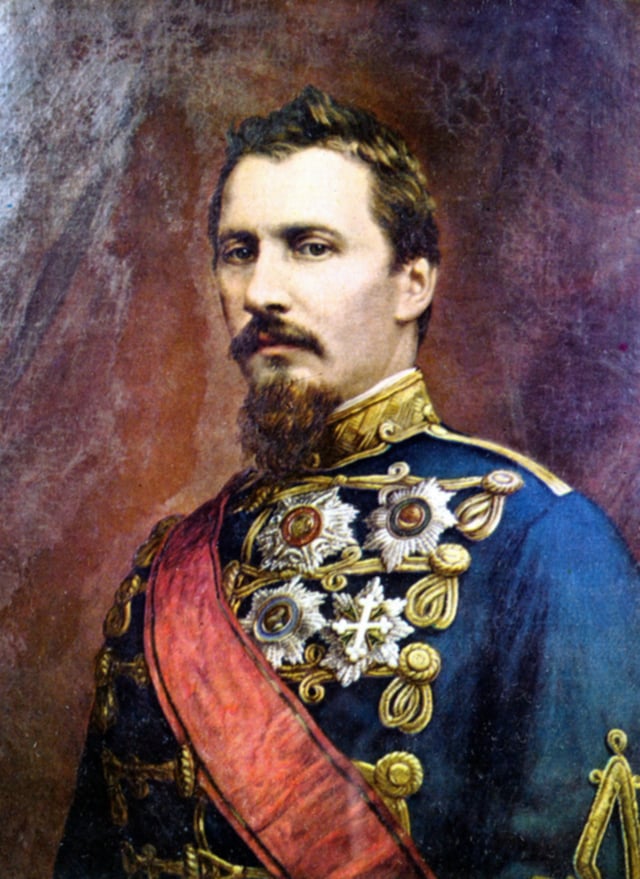
Alexandru Ioan Cuza was the first Domnitor (i.e. Prince) of Romania (at that time the United Principalities of Wallachia and Moldavia) between 1862 and 1866.
The Treaty of Küçük Kaynarca authorised the Russian ambassador in Istanbul to defend the autonomy of Moldavia and Wallachia (known as the Danubian Principalities) in 1774.[127] Taking advantage of the Greek War of Independence, a Wallachian lesser nobleman, Tudor Vladimirescu, stirred up a revolt against the Ottomans in January 1821, but he was murdered in June by Phanariot Greeks.[128] After a new Russo-Turkish War, the Treaty of Adrianople strengthened the autonomy of the Danubian Principalities in 1829, although it also acknowledged the sultan's right to confirm the election of the princes.[129]
Mihail Kogălniceanu, Nicolae Bălcescu and other leaders of the 1848 revolutions in Moldavia and Wallachia demanded the emancipation of the peasants and the union of the two principalities, but Russian and Ottoman troops crushed their revolt.[130][131] The Wallachian revolutionists were the first to adopt the blue, yellow and red tricolour as national flag.[132] In Transylvania, most Romanians supported the imperial government against the Hungarian revolutioners after the Diet passed a law about the union of Transylvania and Hungary.[132] Bishop Andrei Șaguna proposed the unification of the Romanians of the Habsburg Monarchy in a separate duchy, but the central government refused to change the internal frontiers.[133]
The Treaty of Paris put the Danubian Principalities under the collective guardianship of the Great Powers in 1856.[131] After special assemblies convoked in Moldavia and Wallachia urged the unification of the two principalities, the Great Powers did not prevent the election of Alexandru Ioan Cuza as their collective domnitor (or ruling prince) in January 1859.[134] The united principalities officially adopted the name Romania on 21 February 1862.[135] Cuza's government carried out a series of reforms, including the secularization of the property of monasteries and agrarian reform, but a coalition of conservative and radical politicians forced him to abdicate in February 1866.[136][137]
Cuza's successor, a German prince, Karl of Hohenzollern-Sigmaringen (or Carol I), was elected in May.[138] The parliament adopted the first constitution of Romania in the same year.[139] The Great Powers acknowledged Romania's full independence at the Congress of Berlin and Carol I was crowned king in 1881.[140] The Congress also granted the Danube Delta and Dobruja to Romania.[140] Although Romanian scholars strove for the unification of all Romanians into a Greater Romania, the government did not openly support their irredentist projects.[141]
The Transylvanian Romanians and Saxons wanted to maintain the separate status of Transylvania in the Habsburg Monarchy, but the Austro-Hungarian Compromise brought about the union of the province with Hungary in 1867.[142] Ethnic Romanian politicians sharply opposed the Hungarian government's attempts to transform Hungary into a national state, especially the laws prescribing the obligatory teaching of Hungarian.[140] Leaders of the Romanian National Party proposed the federalization of Austria-Hungary and the Romanian intellectuals established cultural association to promote the use of Romanian.[143][144]
World Wars and Greater Romania

Late 19th century ethnic map of Central Europe depicting predominantly Romanian-inhabited territories in blue. Hungarians are marked in yellow and Germans in pink.

King Carol I of Romania with his nephew Ferdinand I of Romania and great-nephew Carol II of Romania.

Romania's territorial losses in the summer of 1940. Of these territories, only Northern Transylvania was regained after the end of World War II.
Fearing of Russian expansionism, Romania secretly joined the Triple Alliance of Germany, Austria-Hungary and Italy in 1883, but public opinion remained hostile to Austria-Hungary.[145][146] Romania seized Southern Dobruja from Bulgaria in the Second Balkan War in 1913.[147] For German and Austrian-Hungarian diplomacy supported Bulgaria during the war, it brought about a rapprochement between Romania and the Triple Entente of France, Russia and the United Kingdom.[147] The country remained neutral when World War I broke out in 1914, but Prime Minister Ion I. C. Brătianu started negotiations with the Entente Powers.[148] After they promised Austrian-Hungarian territories with a majority of ethnic Romanian population to Romania in the Treaty of Bucharest, Romania entered the war against the Central Powers in 1916.[148][149] The German and Austrian-Hungarian troops defeated the Romanian army and occupied three-quarters of the country by early 1917.[150] After the October Revolution turned Russia from ally into enemy, Romania was forced to sign a harsh peace treaty with the Central Powers in May 1918,[151] but the collapse of Russia also enabled the union of Bessarabia with Romania.[152] King Ferdinand again mobilised the Romanian army on behalf of the Entente Powers a day before Germany capitulated on 11 November 1918.[151]
Austria-Hungary quickly disintegrated after the war.[151] The General Congress of Bukovina proclaimed the union of the province with Romania on 28 November 1918, and the Grand National Assembly decided the union of Transylvania, Banat, Crișana and Maramureș with the kingdom on 1 December.[153][154] Peace treaties with Austria, Bulgaria and Hungary delineated the new borders in 1919 and 1920, but the Soviet Union did not acknowledge the loss of Bessarabia.[155] Romania achieved its greatest territorial extend, expanding from the pre-war 137,000 km2 (53,000 sq mi) to 295,000 km2 (114,000 sq mi).[156] A new electoral system granted voting rights to all adult male citizens, and a series of radical agrarian reforms transformed the country into a "nation of small landowners" between 1918 and 1921.[157] Gender equality as a principle was enacted, but women could not vote or be candidates.[158] Calypso Botez established the National Council of Romanian Women to promote feminist ideas.[158] Romania was a multiethnic country, with ethnic minorities making up about 30% of the population, but the new constitution declared it a unitary national state in 1923.[156][159][160] Although minorities could establish their own schools, Romanian language, history and geography could only be taught in Romanian.[161]
Agriculture remained the principal sector of economy, but several branches of industry—especially the production of coal, oil, metals, synthetic rubber, explosives and cosmetics—developed during the interwar period.[162][163] With oil production of 5.8 million tons in 1930, Romania ranked sixth in the world.[163] Two parties, the National Liberal Party and the National Peasants' Party, dominated the political life, but the Great Depression brought about significant changes in the 1930s.[164][165] The democratic parties were squeezed between conflicts with the fascist and Anti-Semitic Iron Guard and the authoritarian tendencies of King Carol II.[166] The King promulgated a new constitution and dissolved the political parties in 1938, replacing the parliamentary system with a royal dictatorship.[167][168]
The 1938 Munich Agreement convinced King Carol II that France and the United Kingdom could no more defend Romanian interests.[169] German preparations for a new war required the regular supply of Romanian oil and agricultural products.[169] The two countries concluded a treaty about the coordination of their economic policies in 1939, but the King could not persuade Adolf Hitler to guarantee Romania's frontiers.[170] Romania was forced to cede Bessarabia and northern Bukovina to the Soviet Union on 26 June 1940, Northern Transylvania to Hungary on 30 August, and Southern Dobruja to Bulgaria in September.[171] After the territorial losses, the King was forced to abdicate in favour of his minor son, Michael I, on 6 September, and Romania was transformed into a national-legionary state under the leadership of General Ion Antonescu.[172] Antonescu signed the Tripartite Pact of Germany, Italy and Japan on 23 November.[173] The Iron Guard staged a coup against Antonescu, but he crushed the riot with German support and introduced a military dictatorship in early 1941.[174]
Romania entered World War II soon after the German invasion of the Soviet Union in June 1941.[175] The country regained Bessarabia and northern Bucovina, and the Germans placed Transnistria (the territory between the rivers Dniester and Dnieper) under Romanian administration.[176] The Romanian and German troops massacred at least 160,000 local Jews in these territories; more than 105,000 Jews and about 11,000 Gypsies died during their deportation from Bessarabia to Transnistria.[177] The vast majority of the Jewish population of Moldavia, Wallachia, Banat and Southern Transylvania survived,[178] but their fundamental rights were limited.[179] After the German occupation of Hungary in March 1944, about 132,000 (mainly Hungarian-speaking) Jews were deported to extermination camps from Northern Transylvania with the Hungarian authorities' support.[177][180]
After the Soviet victory in the Battle of Stalingrad in 1943, Iuliu Maniu, a leader of the opposition to Antonescu, entered into secret negotiations with British diplomats who made it clear that Romania had to seek reconciliation with the Soviet Union.[181] To facilitate the coordination of their activities against Antonescu's regime, the National Liberal and National Peasants' parties established the National Democratic Bloc which also included the Social Democratic and Communist parties.[182] After a successful Soviet offensive, the young King Michael I ordered the arrest of Antonescu and appointed politicians from the National Democratic Bloc to form a new government on 23 August 1944.[183] Romania switched sides in the war, and nearly 250,000 Romanian troops joined the Red Army's military campaign against Hungary and Germany, but Joseph Stalin regarded the country as an occupied territory within the Soviet sphere of influence.[184] Stalin's deputy instructed the King to make the Communists' candidate, Petru Groza, the prime minister in March 1945.[185][186] The Romanian administration in Northern Transylvania was soon restored, and Groza's government carried out an agrarian reform.[186] In February 1947, the Paris Peace Treaties confirmed the return of Northern Transylvania to Romania, but they also legalised the presence of units of the Red Army in the country.[187][188]
Communism

King Michael I of Romania was forced to abdicate by the Communists in late December 1947, concomitant with the Soviet occupation of the country.

Nicolae Ceaușescu ruled Romania as its Communist leader from 1965 until 1989.
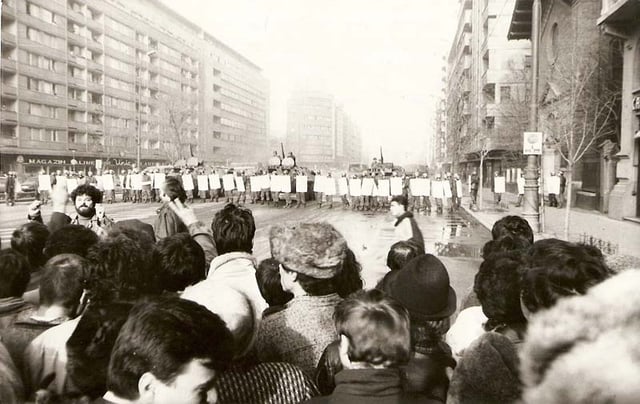
The Romanian Revolution of 1989 was one of the few violent revolutions in the Iron Curtain that brought an end to Communist rule.
During the Soviet occupation of Romania, the Communist-dominated government called for new elections in 1946, which were fraudulently won, with a fabricated 70% majority of the vote.[189] Thus, they rapidly established themselves as the dominant political force.[190] Gheorghe Gheorghiu-Dej, a Communist party leader imprisoned in 1933, escaped in 1944 to become Romania's first Communist leader. In 1947 he and others forced King Michael I to abdicate and leave the country, and proclaimed Romania a people's republic.[191][192] Romania remained under the direct military occupation and economic control of the USSR until the late 1950s. During this period, Romania's vast natural resources were continuously drained by mixed Soviet-Romanian companies (SovRoms) set up for unilateral exploitative purposes.[193][194][195]
In 1948, the state began to nationalise private firms and to collectivise agriculture.[196] Until the early 1960s, the government severely curtailed political liberties and vigorously suppressed any dissent with the help of the Securitate (the Romanian secret police). During this period the regime launched several campaigns of purges in which numerous "enemies of the state" and "parasite elements" were targeted for different forms of punishment, such as deportation, internal exile, and internment in forced labour camps and prisons, sometimes for life, as well as extrajudicial killing.[197] Nevertheless, anti-Communist resistance was one of the most long-lasting in the Eastern Bloc.[198] A 2006 Commission estimated the number of direct victims of the Communist repression at two million people.[199]
In 1965, Nicolae Ceaușescu came to power and started to conduct the foreign policy more independently from the Soviet Union. Thus, Communist Romania was the only Warsaw Pact country which refused to participate in the Soviet-led 1968 invasion of Czechoslovakia (with Ceaușescu at the time even publicly condemning the action as "a big mistake, [and] a serious danger to peace in Europe and to the fate of Communism in the world"[200]); it was also the only Communist state to maintain diplomatic relations with Israel after 1967's Six-Day War; and established diplomatic relations with West Germany the same year.[201] At the same time, close ties with the Arab countries (and the PLO) allowed Romania to play a key role in the Israel–Egypt and Israel–PLO peace talks.[202]
As Romania's foreign debt sharply increased between 1977 and 1981 (from US$3 billion to $10 billion),[203] the influence of international financial organizations (such as the IMF and the World Bank) grew, gradually conflicting with Ceaușescu's autocratic rule. The latter eventually initiated a policy of total reimbursement of the foreign debt by imposing austerity steps that impoverished the population and exhausted the economy. The process succeeded in repaying all foreign government debt of Romania in 1989. At the same time, Ceaușescu greatly extended the authority of the Securitate secret police and imposed a severe cult of personality, which led to a dramatic decrease in the dictator's popularity and culminated in his overthrow and eventual execution, together with his wife, in the violent Romanian Revolution of December 1989 in which thousands were killed or injured. The charges for which they were executed were, among others, genocide by starvation.
Contemporary period

Anti-Communist rally in Bucharest (early 1990)
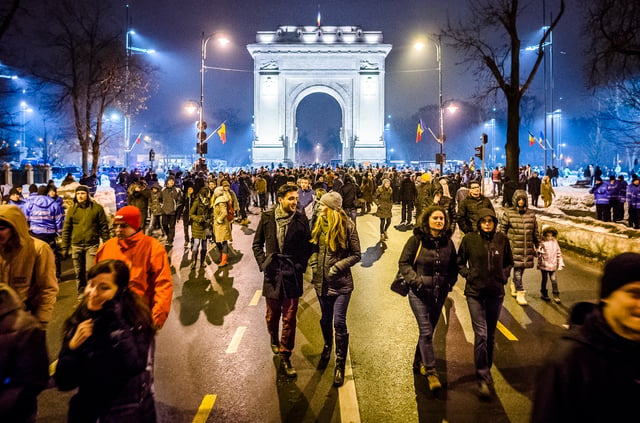
Romania has seen large waves of protests against judicial reforms during the 2017–2019 Romanian protests.
After the 1989 revolution, the National Salvation Front (NSF), led by Ion Iliescu, took partial multi-party democratic and free market measures.[204][205] In April 1990, a sit-in protest contesting the results of that year's legislative elections and accusing the NSF, including Iliescu, of being made up of former Communists and members of the Securitate — rapidly grew to become what was called the Golaniad. The peaceful demonstrations degenerated into violence, prompting the intervention of coal miners summoned by Iliescu. This episode has been documented widely by both local[206] and foreign media,[207] and is remembered as the June 1990 Mineriad.[208][209]
The subsequent disintegration of the Front produced several political parties, including most notably the Social Democratic Party and the Democratic Party. The former governed Romania from 1990 until 1996 through several coalitions and governments with Ion Iliescu as head of state. Since then, there have been several other democratic changes of government: in 1996 Emil Constantinescu was elected president, in 2000 Iliescu returned to power, while Traian Băsescu was elected in 2004 and narrowly re-elected in 2009.[210]
In November 2014, Sibiu (German: Hermannstadt) mayor Klaus Johannis was elected president, unexpectedly defeating former Prime Minister Victor Ponta, who had been in the lead in the opinion polls. This surprise victory is attributed by many to the Romanian diaspora, of which almost 50 percent voted for Iohannis in the first tour, compared to 16 percent for Ponta.[211]
The post-1989 period is also characterised by the fact that most of the former industrial and economic enterprises which were built and operated during the Communist period have been closed, mainly as a result of the policies of privatization of the post-1989 regimes.[212]
Corruption has also been a major issue in contemporary Romanian politics.[213][214][215][216] In November 2015, massive anti-corruption protests which developed in the wake of the Colectiv nightclub fire led to the resignation of Romania's Prime Minister Victor Ponta.[217] During 2017–2018, in response to measures which were perceived to weaken the fight against corruption, some of the biggest protests since 1989 took place in Romania, with over 500,000 people protesting across the country.[218][219]
Nevertheless, in recent years, many efforts have been made to tackle corruption. A National Anticorruption Directorate was formed in the country in 2002, and according to Transparency International's annual Corruption Perceptions Index, Romania has a corruption index similar to Croatia and neighbouring Hungary.[220]
NATO and EU integration
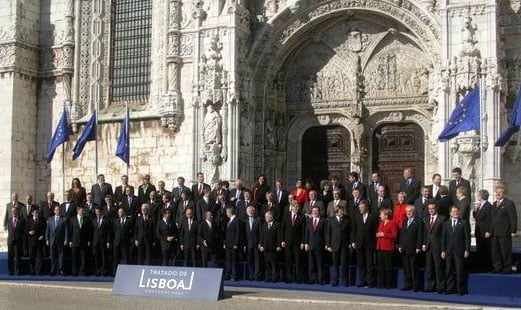
Romania joined the European Union in 2007 and signed the Treaty of Lisbon.
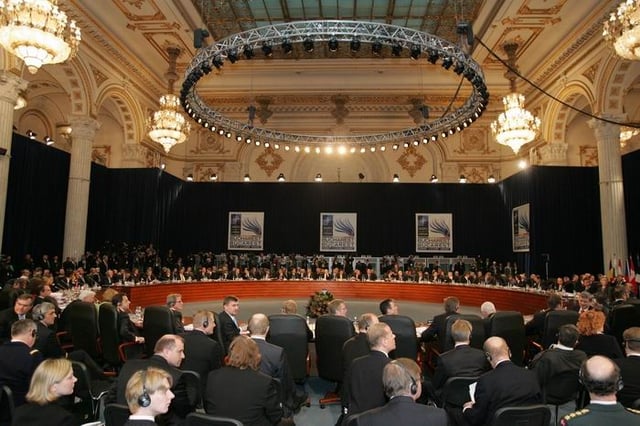
Romania joined NATO in 2004 and hosted its 2008 summit in Bucharest.
After the end of the Cold War, Romania developed closer ties with Western Europe and the United States, eventually joining NATO in 2004, and hosting the 2008 summit in Bucharest.[221]
The country applied in June 1993 for membership in the European Union and became an Associated State of the EU in 1995, an Acceding Country in 2004, and a full member on 1 January 2007.[222]
During the 2000s, Romania enjoyed one of the highest economic growth rates in Europe and has been referred at times as "the Tiger of Eastern Europe".[223] This has been accompanied by a significant improvement in living standards as the country successfully reduced internal poverty and established a functional democratic state.[224][225] However, Romania's development suffered a major setback during the late-2000s recession leading to a large gross domestic product contraction and budget deficit in 2009.[226] This led to Romania borrowing from the International Monetary Fund.[227] The worsening economic conditions led to unrest and triggered a political crisis in 2012.[228]
Romania still faces problems related to infrastructure,[229] medical services,[230] education,[231] and corruption.[232] Near the end of 2013, The Economist reported Romania again enjoying 'booming' economic growth at 4.1% that year, with wages rising fast and a lower unemployment than in Britain. Economic growth accelerated in the midst of government liberalisations in opening up new sectors to competition and investment—most notably, energy and telecoms.[233] In 2016 the Human Development Index ranked Romania as a nation of "Very High Human Development".[234]
Following the experience of economic instability throughout the 1990s, and the implementation of a free travel agreement with the EU, a great number of Romanians emigrated to Western Europe and North America, with particularly large communities in Italy, Germany and Spain. In 2016, the Romanian diaspora was estimated to be at over 3.6 million people, the fifth-highest emigrant population in the world.[235]
Geography and climate
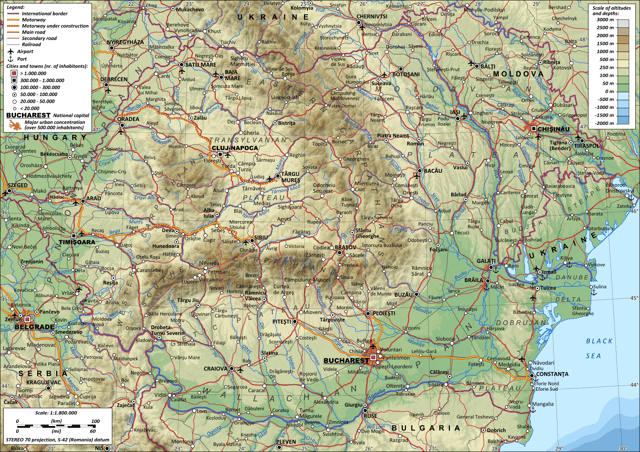
Topographic map of Romania
With an area of 238,397 square kilometres (92,046 sq mi), Romania is the largest country in Southeastern Europe and the twelfth-largest in Europe.[236] [] It lies between latitudes 43° and 49° N and longitudes 20° and 30° E.
The terrain is distributed roughly equally between mountains, hills, and plains.
The Carpathian Mountains dominate the centre of Romania, with 14 mountain ranges reaching above 2,000 m or 6,600 ft, the highest of which is Moldoveanu Peak at 2,544 m or 8,346 ft.[236] [] They are surrounded by the Moldavian and Transylvanian plateaus and Carpathian Basin and Wallachian plains.
The Danube river forms a large part of the border with Serbia and Bulgaria, and flows into the Black Sea, forming the Danube Delta, which is the second-largest and best-preserved delta in Europe, and also a biosphere reserve and a biodiversity World Heritage Site.[239] At 5,800 km2 (2,200 sq mi),[240] the Danube Delta is the largest continuous marshland in Europe,[241] and supports 1,688 different plant species alone.[242]
The fauna of Romania consists of 33,792 species of animals, 33,085 invertebrate and 707 vertebrate,[244] with almost 400 unique species of mammals, birds, reptiles, and amphibians,[245] including about 50% of Europe's (excluding Russia) brown bears[246] and 20% of its wolves.[247]
Climate
Owing to its distance from open sea and position on the southeastern portion of the European continent, Romania has a climate that is temperate and continental, with four distinct seasons. The average annual temperature is 11 °C (52 °F) in the south and 8 °C (46 °F) in the north.[248] In summer, average maximum temperatures in Bucharest rise to 28 °C (82 °F), and temperatures over 35 °C (95 °F) are fairly common in the lower-lying areas of the country.[249] In winter, the average maximum temperature is below 2 °C (36 °F).[249] Precipitation is average, with over 750 mm (30 in) per year only on the highest western mountains, while around Bucharest it drops to approximately 570 mm (22 in).[236] [] There are some regional differences: in western sections, such as Banat, the climate is milder and has some Mediterranean influences; the eastern part of the country has a more pronounced continental climate. In Dobruja, the Black Sea also exerts an influence over the region's climate.[250]
| Location | July (°C) | July (°F) | January (°C) | January (°F) |
|---|---|---|---|---|
| Bucharest | 28.8/15.6 | 84/60 | 1.5/−5.5 | 35/22 |
| Cluj-Napoca | 24.5/12.7 | 76/55 | 0.3/−6.5 | 33/20 |
| Timișoara | 27.8/14.6 | 82/58 | 2.3/−4.8 | 36/23 |
| Iași | 26.8/15 | 80/59 | −0.1/−6.9 | 32/20 |
| Constanța | 25.9/18 | 79/64 | 3.7/−2.3 | 39/28 |
| Craiova | 28.5/15.7 | 83/60 | 1.5/−5.6 | 35/22 |
| Brașov | 24.2/11.4 | 76/53 | −0.1/−9.3 | 32/15 |
| Galați | 27.9/16.2 | 82/61 | 1.1/–5.3 | 34/22 |
Governance
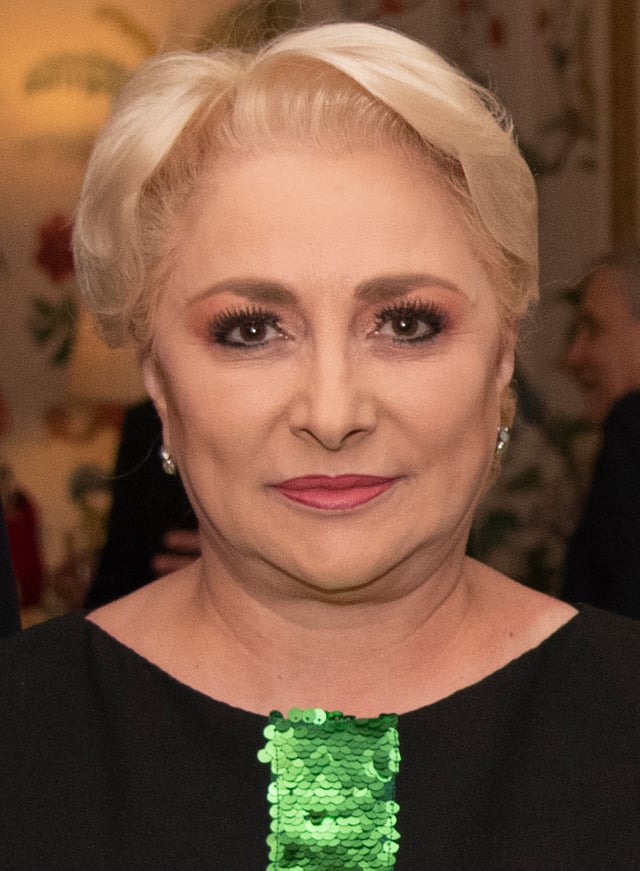
Viorica DăncilăPrime Minister
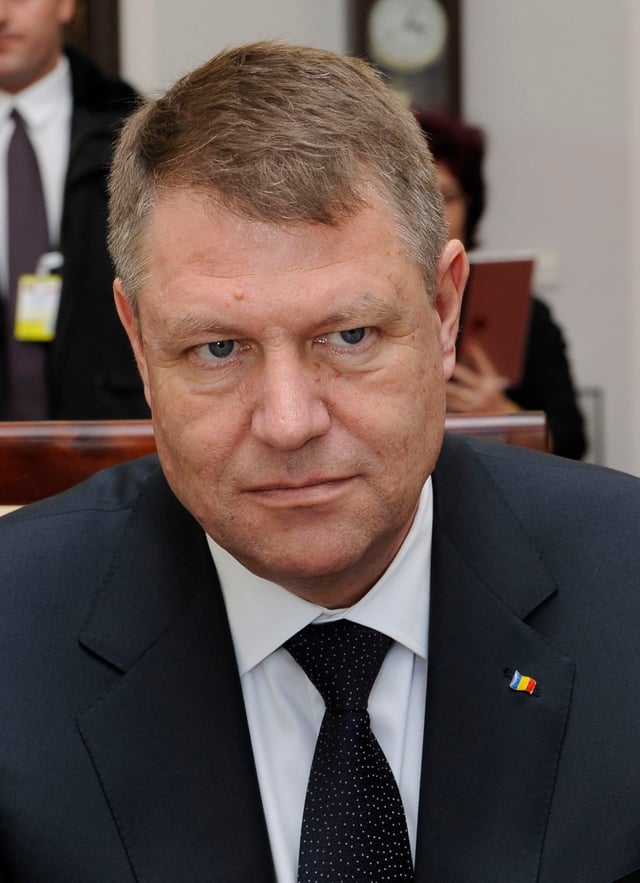
Klaus IohannisPresident
The Constitution of Romania is based on the Constitution of France's Fifth Republic and was approved in a national referendum on 8 December 1991, and amended in October 2003 to bring it into conformity with the EU legislation. The country is governed on the basis of a multi-party democratic system and the separation of powers between the legislative, executive and judicial branches. It is a semi-presidential republic where executive functions are held by both the government and the president.[252] The latter is elected by popular vote for a maximum of two terms of five years and appoints the prime minister, who in turn appoints the Council of Ministers. The legislative branch of the government, collectively known as the Parliament (residing at the Palace of the Parliament), consists of two chambers (Senate and Chamber of Deputies) whose members are elected every four years by simple plurality.[253][254]
The justice system is independent of the other branches of government, and is made up of a hierarchical system of courts culminating in the High Court of Cassation and Justice, which is the supreme court of Romania.[255] There are also courts of appeal, county courts and local courts. The Romanian judicial system is strongly influenced by the French model, considering that it is based on civil law and is inquisitorial in nature. The Constitutional Court (Curtea Constituțională) is responsible for judging the compliance of laws and other state regulations to the constitution, which is the fundamental law of the country and can only be amended through a public referendum.[253][256] The 2007 entry into the EU has been a significant influence on its domestic policy, and including judicial reforms, increased judicial cooperation with other member states, and measures to combat corruption.
Foreign relations
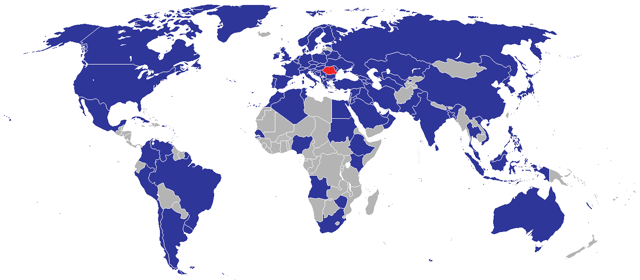
Diplomatic missions of Romania

Romania is a noteworthy ally of the United States, being the first NATO member state that agreed to support increasing its defence spending after the 2017 Trump-Iohannis meeting at the White House.
Since December 1989, Romania has pursued a policy of strengthening relations with the West in general, more specifically with the United States and the European Union, albeit with limited relations involving the Russian Federation. It joined the North Atlantic Treaty Organization (NATO) on 29 March 2004, the European Union (EU) on 1 January 2007, while it had joined the International Monetary Fund and the World Bank in 1972, and is a founding member of the World Trade Organization.[257]
Past recent governments states that one of their goals is to strengthen ties with and helping other countries (in particular Moldova, Ukraine, and Georgia) with the process of integration with the rest of the West.[258] Romania has also made clear since the late 1990s that it supports NATO and EU membership for the democratic former Soviet republics in Eastern Europe and the Caucasus.[258] Romania also declared its public support for Turkey, and Croatia joining the European Union.[258] Because it has a large Hungarian minority, Romania has also developed strong relations with Hungary.
Romania opted on 1 January 2007, to accede to the Schengen Area, and its bid to join was approved by the European Parliament in June 2011, but was rejected by the EU Council in September 2011. As of August 2019, its acceptance into the Schengen Area is hampered because the European Council has misgivings about Romania's adherence to the rule of law,[259] a fundamental principle of EU membership.[260]
In December 2005, President Traian Băsescu and United States Secretary of State Condoleezza Rice signed an agreement that would allow a U.S. military presence at several Romanian facilities primarily in the eastern part of the country.[261] In May 2009, Hillary Clinton, US Secretary of State, declared that "Romania is one of the most trustworthy and respectable partners of the USA."[262]
Relations with Moldova are a special case, considering that the two countries share the same language and a common history.[258] A movement for unification of Romania and Moldova appeared in the early 1990s after both countries achieved emancipation from communist rule,[263] but lost ground in the mid-1990s when a new Moldovan government pursued an agenda towards preserving a Moldovan republic independent of Romania.[264] After the 2009 protests in Moldova and subsequent removal of Communists from power, relations between the two countries have improved considerably.[265]
Military
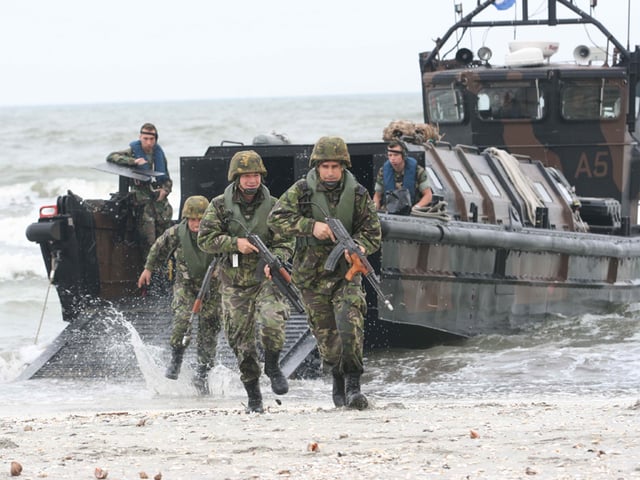
Romanian marine troopers during a combined Dutch-Romanian exercise at Vadu beach.
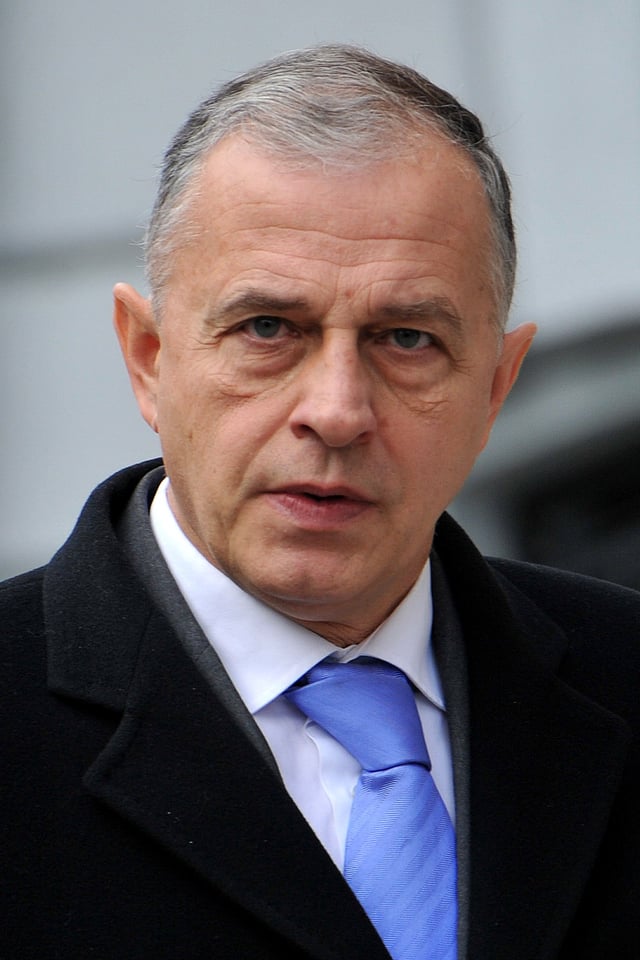
Romanian Mircea Geoană, Deputy Secretary General of NATO.
The Romanian Armed Forces consist of Land, Air, and Naval Forces, and are led by a Commander-in-chief under the supervision of the Ministry of National Defence, and by the president as the Supreme Commander during wartime. The Armed Forces consist of approximately 15,000 civilians and 75,000 are military personnel—45,800 for land, 13,250 for air, 6,800 for naval forces, and 8,800 in other fields.[266] The total defence spending in 2007 accounted for 2.05% of total national GDP, or approximately US$2.9 billion, with a total of $11 billion spent between 2006 and 2011 for modernization and acquisition of new equipment.[267]
The Air Force currently operates modernised Soviet MiG-21 Lancer fighters which are due to be replaced by twelve F-16s, recently purchased.[268] The Air Force purchased seven new C-27J Spartan tactical airlifters,[269] while the Naval Forces acquired two modernised Type 22 frigates from the British Royal Navy.[270]
Romania has contributed troops to the international coalition in Afghanistan since 2002,[271] with a peak deployment of 1,600 troops in 2010 (which was the 4th largest contributor according to the US).[272][273] Its combat mission in the country concluded in 2014.[274] Romanian troops participated in the occupation of Iraq, reaching a peak of 730 soldiers before being slowly drawn down to 350 soldiers. Romania terminated its mission in Iraq and withdrew its last troops on 24 July 2009, among the last countries to do so. The Regele Ferdinand frigate participated in the 2011 military intervention in Libya.[275]
In December 2011, the Romanian Senate unanimously adopted the draft law ratifying the Romania-United States agreement signed in September of the same year that would allow the establishment and operation of a US land-based ballistic missile defence system in Romania as part of NATO's efforts to build a continental missile shield.[276]
Administrative divisions
Romania is divided into 41 counties (județe, pronounced judetse) and the municipality of Bucharest. Each county is administered by a county council, responsible for local affairs, as well as a prefect responsible for the administration of national affairs at the county level. The prefect is appointed by the central government but cannot be a member of any political party.[277] Each county is further subdivided into cities and communes, which have their own mayor and local council. There are a total of 320 cities and 2,861 communes in Romania.[236] [] A total of 103 of the larger cities have municipality statuses, which gives them greater administrative power over local affairs. The municipality of Bucharest is a special case as it enjoys a status on par to that of a county. It is further divided into six sectors[236] [] and has a prefect, a general mayor (primar), and a general city council.
The NUTS-3 (Nomenclature of Territorial Units for Statistics) level divisions of European Union reflect Romania's administrative-territorial structure, and correspond to the 41 counties plus Bucharest.[278] The cities and communes correspond to the NUTS-5 level divisions, but there are no current NUTS-4 level divisions. The NUTS-1 (four macroregions) and NUTS-2[279] (eight development regions) divisions exist but have no administrative capacity, and are instead used for coordinating regional development projects and statistical purposes.[278]
| Development region | Area (km2) | Population (2011)[280] | Most populous urban centre |
|---|---|---|---|
| Nord-Vest | 34,159 | 2,600,132 | Cluj-Napoca (411,379) |
| Centru | 34,082 | 2,360,805 | Brașov (369,896) |
| Nord-Est | 36,850 | 3,302,217 | Iași (382,484) |
| Sud-Est | 35,762 | 2,545,923 | Constanța (425,916) |
| Sud – Muntenia | 34,489 | 3,136,446 | Ploiești (276,279) |
| București – Ilfov | 1,811 | 2,272,163 | Bucharest (2,272,163) |
| Sud-Vest Oltenia | 29,212 | 2,075,642 | Craiova (356,544) |
| Vest | 32,028 | 1,828,313 | Timișoara (384,809) |
Economy

Since 2007, Romania has been part of the EU single market.

The CEC Palace is situated on Bucharest's Victory Avenue.
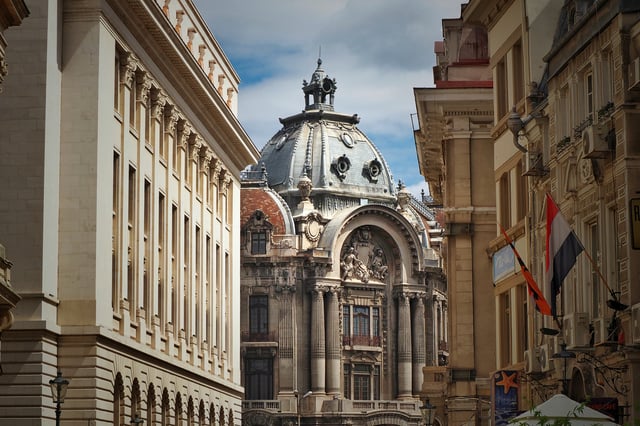
The Bucharest Stock Exchange Palace, situated in the capital's historical city centre.
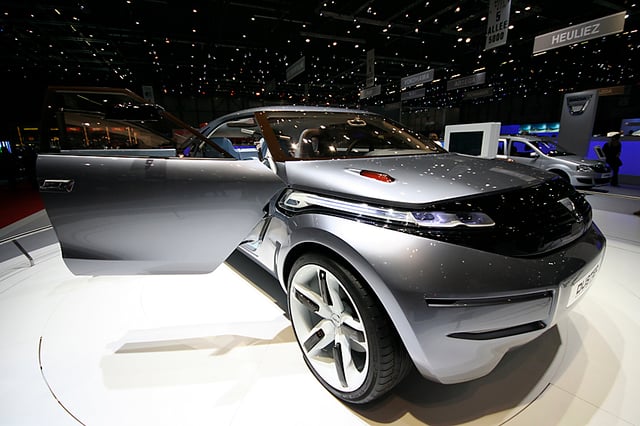
Dacia Duster concept at the Geneva Motor Show (2009)
In 2019, Romania has a GDP (PPP) of around $547 billion and a GDP per capita (PPP) of $28,189.[282] According to the World Bank, Romania is a high income country with a mixed economy.[283] According to Eurostat, Romania's GDP per capita (PPS) was at 64% of the EU average in 2018, an increase from 41% in 2007 (the year of Romania's accession to the EU), making Romania one of the fastest growing economies in the EU.[284]
After 1989 the country experienced a decade of economic instability and decline, led in part by an obsolete industrial base and a lack of structural reform. From 2000 onward, however, the Romanian economy was transformed into one of relative macroeconomic stability, characterised by high growth, low unemployment and declining inflation. In 2006, according to the Romanian Statistics Office, GDP growth in real terms was recorded at 7.7%, one of the highest rates in Europe.[285] However, a recession following the global financial crisis of 2008–2009 forced the government to borrow externally, including an IMF €20bn bailout program.[286] GDP has been growing by over 2% each year since.[287] According to The World Bank, the GDP per capita purchasing power parity grew from $13,442 in 2007 to an estimated $22,124 in 2015.[288] Romania still has one of the lowest net average monthly wages in the EU of €540 in 2016,[289] and an inflation rate of −1.1% in 2016.[290] Unemployment in Romania is at 4.3% in August 2018, which is very low compared to other EU countries.[288]
Industrial output growth reached 6.5% year-on-year in February 2013, the highest in the EU-27.[291] The largest local companies include car maker Automobile Dacia, Petrom, Rompetrol, Ford Romania, Electrica, Romgaz, RCS & RDS and Banca Transilvania.[292] Exports have increased substantially in the past few years, with a 13% annual rise in exports in 2010. Romania's main exports are cars, software, clothing and textiles, industrial machinery, electrical and electronic equipment, metallurgic products, raw materials, military equipment, pharmaceuticals, fine chemicals, and agricultural products (fruits, vegetables, and flowers). Trade is mostly centred on the member states of the European Union, with Germany and Italy being the country's single largest trading partners. The account balance in 2012 was estimated to be −4.52% of the GDP.[293]
After a series of privatizations and reforms in the late 1990s and 2000s, government intervention in the Romanian economy is somewhat lower than in other European economies.[294] In 2005, the government replaced Romania's progressive tax system with a flat tax of 16% for both personal income and corporate profit, among the lowest rates in the European Union.[295] The economy is predominantly based on services, which account for 56.2% of the country's total GDP as of 2017, with industry and agriculture accounting for 30% and 4.4% respectively.[296] Approximately 25.8% of the Romanian workforce is employed in agriculture, one of the highest rates in Europe.[297]
Romania has attracted increasing amounts of foreign investment following the end of Communism, with the stock of foreign direct investment (FDI) in Romania rising to €83.8 billion in June 2019.[298] Romania's FDI outward stock amounted to $745 million in December 2018, the lowest value among the 28 EU member states.[298]
According to a 2019 World Bank report, Romania ranks 52nd out of 190 economies in the ease of doing business, one place higher than neighbouring Hungary and one place lower than Italy.[299] The report praised the consistent enforcement of contracts and access to credit in the country, while noting difficulties in access to electricity and dealing with construction permits.[299]
Infrastructure

Romania's road network.

Graph depicting Romania's electricity supply mix as of 2015
According to the INSSE, Romania's total road network was estimated in 2015 at 86,080 kilometres (53,488 mi).[303] The World Bank estimates the railway network at 22,298 kilometres (13,855 mi) of track, the fourth-largest railroad network in Europe.[304] Rail transport experienced a dramatic decline after 1989, and was estimated at 99 million passenger journeys in 2004; but has experienced a recent (2013) revival due to infrastructure improvements and partial privatization of lines,[253] accounting for 45% of all passenger and freight movements in the country.[253] Bucharest Metro, the only underground railway system, was opened in 1979 and measures 61.41 km (38.16 mi) with an average ridership in 2007 of 600,000 passengers during the workweek.[305] There are sixteen international commercial airports in service today. Over 12.8 million passengers flew through Bucharest's Henri Coandă International Airport in 2017.[306]
Romania is a net exporter of electrical energy and is 48th worldwide in terms of consumption of electric energy.[307] Around a third of the produced energy comes from renewable sources, mostly as hydroelectric power.[308] In 2015, the main sources were coal (28%), hydroelectric (30%), nuclear (18%), and hydrocarbons (14%).[309] It has one of the largest refining capacities in Eastern Europe, even though oil and natural gas production has been decreasing for more than a decade.[307] With one of the largest reserves of crude oil and shale gas in Europe,[307] it is among the most energy-independent countries in the European Union,[310] and is looking to further expand its nuclear power plant at Cernavodă.[311]
Tourism
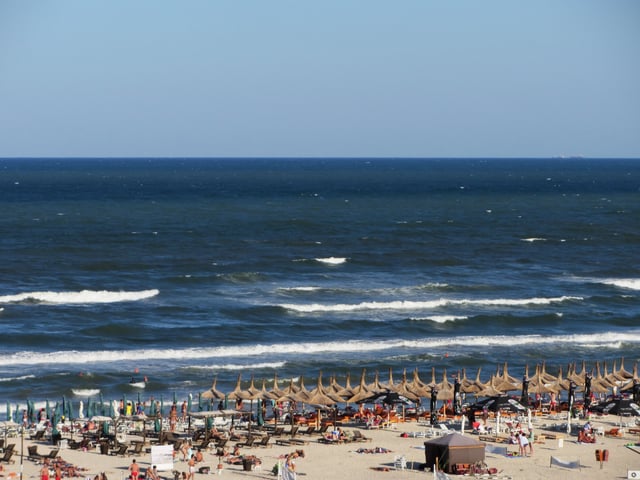
Mamaia Black Sea resort
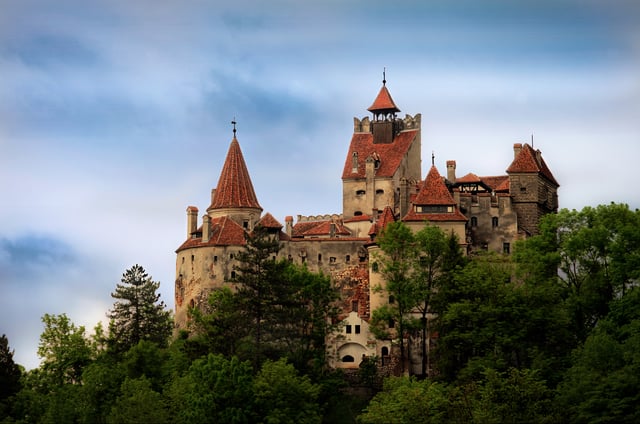
Bran Castle
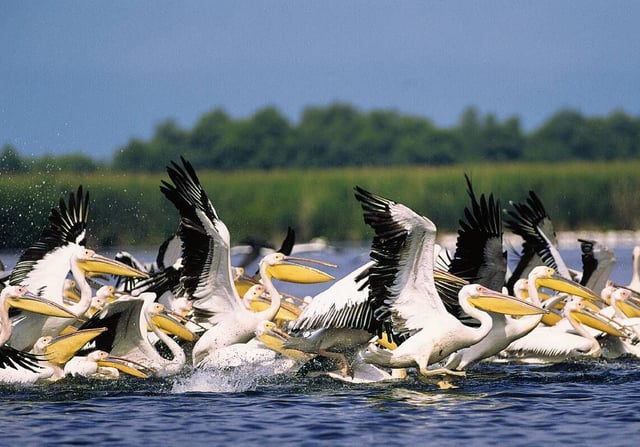
The Danube Delta with its wildlife
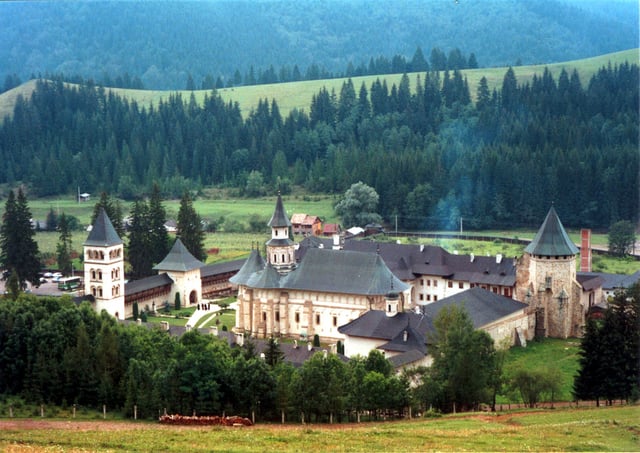
Putna Monastery in Bukovina, the oldest of the medieval churches of Moldavia
Tourism is a significant contributor to the Romanian economy, generating around 5% of GDP.[316] According to the World Travel and Tourism Council, Romania was estimated to have the fourth-fastest-growing travel and tourism total demand in the world, with an estimated potential growth of 8% per year from 2007 to 2016.[317] The number of tourists has been steadily rising, reaching 9.33 million foreign tourists in 2016, according to the Worldbank.[318] Tourism in Romania attracted €400 million in investments in 2005.[319]
Most popular skiing resorts are along the Valea Prahovei and in Poiana Brașov. Castles, fortifications, or strongholds as well as well preserved medieval Transylvanian cities or towns such as Cluj-Napoca, Sibiu, Brașov, Bistrița, Mediaș, Cisnădie, or Sighișoara also attract a large number of tourists. Bran Castle, near Brașov, is one of the most famous attractions in Romania, drawing hundreds of thousands of tourists every year as it is often advertised as being Dracula's Castle.[323] Hunedoara Castle is another famous structure.
Rural tourism, focusing on folklore and traditions, has become an important alternative,[324] and is targeted to promote such sites as Bran and its Dracula's Castle, the painted churches of northern Moldavia, and the wooden churches of Maramureș, or the villages with fortified churches in Transylvania.[325] Other attractions include the Danube Delta or the Sculptural Ensemble of Constantin Brâncuși at Târgu Jiu.[326][327]
In 2014, Romania had 32,500 companies which were active in the hotel and restaurant industry, with a total turnover of EUR 2.6 billion.[328] More than 1.9 million foreign tourists visited Romania in 2014, 12% more than in 2013.[329] According to the country's National Statistics Institute, some 77% came from Europe (particularly from Germany, Italy, and France), 12% from Asia, and less than 7% from North America.[329]
Science and technology
Historically, Romanian researchers and inventors have made notable contributions to several fields. In the history of flight, Traian Vuia made the first airplane to take off on its own power[330] and Aurel Vlaicu built and flew some of the earliest successful aircraft, while Henri Coandă discovered the Coandă effect of fluidics. Victor Babeș discovered more than 50 types of bacteria; biologist Nicolae Paulescu discovered insulin, while Emil Palade, received the Nobel Prize for his contributions to cell biology. Lazăr Edeleanu was the first chemist to synthesise amphetamine and he also invented the procedure of separating valuable petroleum components with selective solvents, while Costin Nenițescu developed numerous new classes of compounds in organic chemistry. Notable Romanian mathematicians include Spiru Haret, Grigore Moisil, and Ștefan Odobleja; physicists and inventors: Șerban Țițeica, Alexandru Proca, and Ștefan Procopiu.
During the 1990s and 2000s, the development of research was hampered by several factors, including corruption, low funding and a considerable brain drain.[331] In recent years, Romania has ranked the lowest or second-lowest in the European Union by research and development spending as a percentage of GDP, standing at roughly 0.5% in 2016 and 2017, substantially below the EU average of just over 2%.[332][333] The country joined the European Space Agency (ESA) in 2011,[334] and CERN in 2016.[335] In 2018, however, Romania lost its voting rights in the ESA due to a failure to pay 56.8 million EUR in membership contributions to the agency.[336]
The nuclear physics facility of the European Union's proposed Extreme Light Infrastructure (ELI) laser will be built in Romania.[339] In early 2012, Romania launched its first satellite from the Centre Spatial Guyanais in French Guyana.[340] Starting December 2014, Romania is a co-owner of the International Space Station.[341]
Demographics
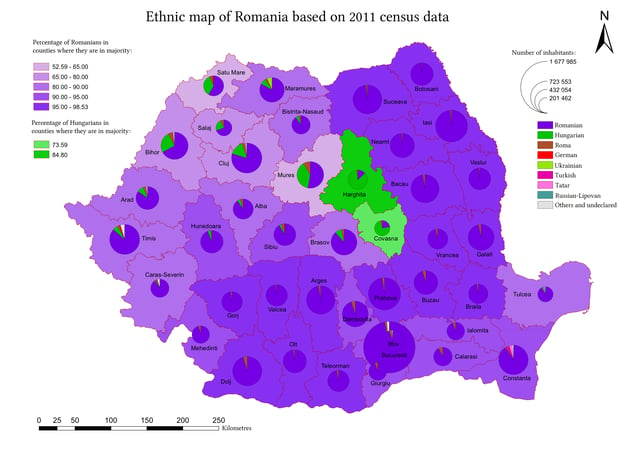
Ethnic map of Romania based on 2011 census data.

Ethnic map of the Kingdom of Romania based on the 1930 census data.
According to the 2011 census, Romania's population is 20,121,641.[7] Like other countries in the region, its population is expected to gradually decline in the coming years as a result of sub-replacement fertility rates and negative net migration rate. In October 2011, Romanians made up 88.9% of the population. The largest ethnic minorities are the Hungarians, 6.1% of the population, and the Roma, 3.0% of the population.[4][342] Hungarians constitute a majority in the counties of Harghita and Covasna. Other minorities include Ukrainians, Germans, Turks, Lipovans, Aromanians, Tatars, and Serbs.[343] In 1930, there were 745,421 Germans in Romania,[344] but only about 36,000 remain today.[343] As of 2009, there were also approximately 133,000 immigrants living in Romania, primarily from Moldova and China.[224]
The total fertility rate (TFR) in 2018 was estimated at 1.36 children born per woman, which is below the replacement rate of 2.1, and one of the lowest in the world,[345] it remains considerably below the high of 5.82 children born per woman in 1912.[346] In 2014, 31.2% of births were to unmarried women.[347] The birth rate (9.49‰, 2012) is much lower than the mortality rate (11.84‰, 2012), resulting in a shrinking (−0.26% per year, 2012) and aging population (median age: 41.6 years, 2018), one of the oldest populations in the world,[345] with approximately 16.8% of total population aged 65 years and over.[348][349][345] The life expectancy in 2015 was estimated at 74.92 years (71.46 years male, 78.59 years female).[350]
The number of Romanians and individuals with ancestors born in Romania living abroad is estimated at around 12 million.[351] After the Romanian Revolution of 1989, a significant number of Romanians emigrated to other European countries, North America or Australia.[352] For example, in 1990, 96,919 Romanians permanently settled abroad.[353]
Languages

Romanian is a Balkan Romance language, part of the larger linguistic family of Romance languages alongside French, Italian, Spanish, Portuguese and Catalan.
The official language is Romanian, a Romance language (the most widely spoken of the Eastern Romance branch), which presents a consistent degree of similarity to Aromanian, Megleno-Romanian, and Istro-Romanian, but equally shares many features with the rest of the Western Romance languages, specifically Italian, French, Spanish, Portuguese, and Catalan. The Romanian alphabet contains the same 26 letters of the standard Latin alphabet, as well as five additional ones (namely 'ă','â','î','ț', and 'ș'), totaling 31.
Romanian is spoken as a first language by approximately 90% of the entire population, while Hungarian and Vlax Romani are spoken by 6.2% and 1.2% of the population, respectively. There are also approximately 50,000 native speakers of Ukrainian (concentrated in some compact regions, near the border, where they form local majorities),[354] 25,000 native speakers of German, and 32,000 native speakers of Turkish living in Romania.[355]
According to the Constitution, local councils ensure linguistic rights to all minorities, with localities with ethnic minorities of over 20%, that minority's language can be used in the public administration, justice system, and education. Foreign citizens and stateless persons that live in Romania have access to justice and education in their own language.[356] English and French are the main foreign languages taught in schools.[357] In 2010, the Organisation internationale de la Francophonie identifies 4,756,100 French speakers in the country.[358] According to the 2012 Eurobarometer, English is spoken by 31% of Romanians, French is spoken by 17%, as well as Italian and German, each by 7%.[359]
Religion

Eastern Orthodoxy is the most widespread religious denomination in the country.
Romania is a secular state and has no state religion. An overwhelming majority of the population identify themselves as Christians. At the country's 2011 census, 81.0% of respondents identified as Orthodox Christians belonging to the Romanian Orthodox Church. Other denominations include Protestantism (6.2%), Roman Catholicism (4.3%), and Greek Catholicism (0.8%). From the remaining population, 195,569 people belong to other Christian denominations or have another religion, which includes 64,337 Muslims (mostly of Turkish and Tatar ethnicity) and 3,519 Jewish (Jews once constituted 4% of the Romanian population, 728,115 persons in the 1930 census). Moreover, 39,660 people have no religion or are atheist, whilst the religion of the rest is unknown.[360]
The Romanian Orthodox Church is an autocephalous Eastern Orthodox Church in full communion with other Orthodox churches, with a Patriarch as its leader. It is the second-largest Orthodox Church in the world, and unlike other Orthodox churches, it functions within a Latin culture and utilises a Romance liturgical language.[361] Its canonical jurisdiction covers the territories of Romania and Moldova,[362] with dioceses for Romanians living in nearby Serbia and Hungary, as well as diaspora communities in Central and Western Europe, North America and Oceania.
Urbanization
Although 54.0% of the population lived in urban areas in 2011,[7] this percentage has been declining since 1996.[363] Counties with over ⅔ urban population are Hunedoara, Brașov and Constanța, while with less than a third are Dâmbovița (30.06%) and Giurgiu and Teleorman.[7] Bucharest is the capital and the largest city in Romania, with a population of over 1.8 million in 2011. Its larger urban zone has a population of almost 2.2 million,[364] which are planned to be included into a metropolitan area up to 20 times the area of the city proper.[365][366][367] Another 19 cities have a population of over 100,000, with Cluj-Napoca and Timișoara of slightly more than 300,000 inhabitants, Iași, Constanța, Craiova, and Brașov with over 250,000 inhabitants, and Galați and Ploiești with over 200,000 inhabitants.[281] Metropolitan areas have been constituted for most of these cities.
Education
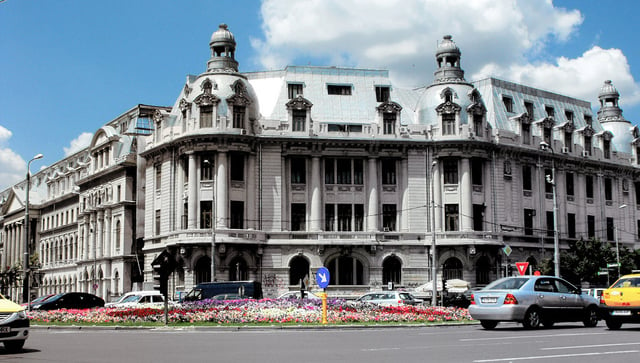
University of Bucharest was opened in 1864.
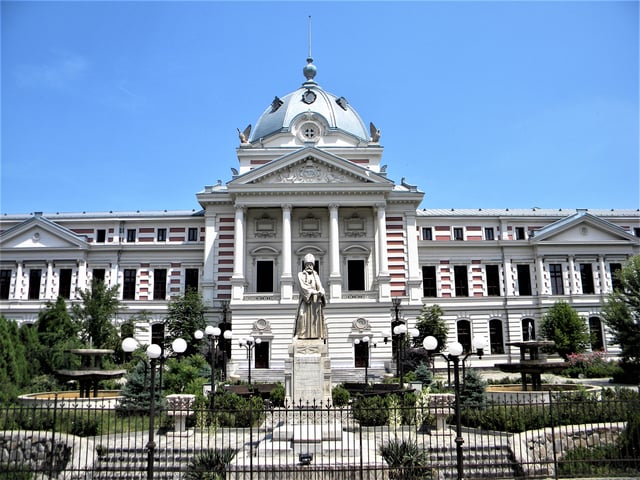
The Colțea Hospital in Bucharest completed a $90 million renovation in 2011.[369]
Since the Romanian Revolution of 1989, the Romanian educational system has been in a continuous process of reform that has received mixed criticism.[370] In 2004, some 4.4 million of the population were enrolled in school. Out of these, 650,000 in kindergarten (3–6 years), 3.11 million in primary and secondary level, and 650,000 in tertiary level (universities).[371] In 2018, the adult literacy rate was 98.8%.[372] Kindergarten is optional between 3 and 6 years. Since 2012, compulsory schooling starts at age 6 with the "preparatory school year" (clasa pregătitoare)[373] and is compulsory until tenth grade.[374] Primary and secondary education is divided into 12 or 13 grades. There also exists a semi-legal, informal private tutoring system used mostly during secondary school, which has prospered during the Communist regime.[375]
Alexandru Ioan Cuza University of Iași, Babeș-Bolyai University of Cluj-Napoca, University of Bucharest, and West University of Timișoara have been included in the QS World University Rankings' top 800.[376]
Romania ranks 5th in the all-time medal count at the International Mathematical Olympiad with 316 total medals, dating back to 1959. Ciprian Manolescu managed to write a perfect paper (42 points) for gold medal more times than anybody else in the history of the competition, doing it all three times he participated in the IMO (1995, 1996, 1997).[377] Romania has achieved the highest team score in the competition, after China and Russia, and right after the United States and Hungary. Romania also ranks 6th in the all-time medal count at the International Olympiad in Informatics with 107 total medals, dating back to 1989.[378][379][380]
Healthcare
Romania has a universal health care system, and total health expenditures by the government are roughly 5% of the GDP.[381] It covers medical examinations, any surgical interventions, and any post-operator medical care, and provides free or subsidised medicine for a range of diseases. The state is obliged to fund public hospitals and clinics. The most common causes of death are cardiovascular diseases and cancer. Transmissible diseases are quite common by European standards.[382] In 2010, Romania had 428 state and 25 private hospitals,[383] with 6.2 hospital beds per 1,000 people,[384] and over 200,000 medical staff, including over 52,000 doctors.[385] As of 2013, the emigration rate of doctors was 9%, higher than the European average of 2.5%.[386]
Culture
Arts and monuments

Sibiu was the European Capital of Culture in 2007.
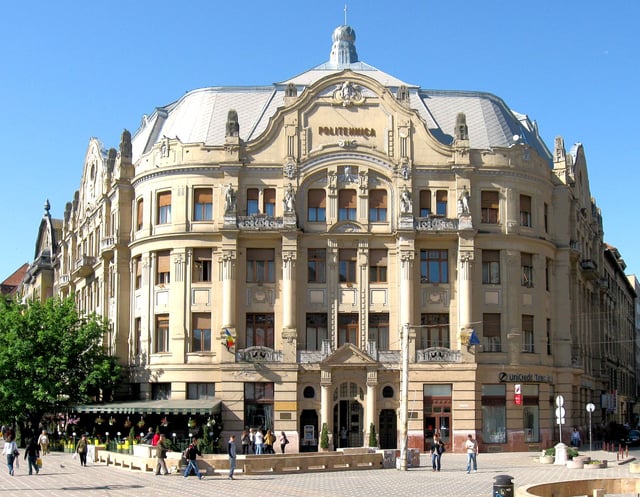
Timișoara was designated the European Capital of Culture in 2021.
The topic of the origin of the Romanians began to be discussed by the end of the 18th century among the Transylvanian School scholars.[387] Several writers rose to prominence in the 19th century, including George Coșbuc, Ioan Slavici, Mihail Kogălniceanu, Vasile Alecsandri, Nicolae Bălcescu, Ion Luca Caragiale, Ion Creangă, and Mihai Eminescu, the later being considered the greatest and most influential Romanian poet, particularly for the poem Luceafărul.[388]
In the 20th century, Romanian artists reached international acclaim, including Tristan Tzara, Marcel Janco,[389] Mircea Eliade, Nicolae Grigorescu, Marin Preda, Liviu Rebreanu,[390] Eugène Ionesco, Emil Cioran, and Constantin Brâncuși. The last has a sculptural ensemble in Târgu Jiu, while his sculpture Bird in Space, was auctioned in 2005 for $27.5 million.[391][392] Romanian-born Holocaust survivor Elie Wiesel received the Nobel Peace Prize in 1986, while Banat Swabian writer Herta Müller received the Nobel Prize in Literature in 2009.
Prominent Romanian painters include Nicolae Grigorescu, Ștefan Luchian, Ion Andreescu Nicolae Tonitza and Theodor Aman. Notable Romanian classical composers of the 19th and 20th centuries include Ciprian Porumbescu, Anton Pann, Eduard Caudella, Mihail Jora, Dinu Lipatti and especially George Enescu. The annual George Enescu Festival is held in Bucharest in honor of the 20th-century eponymous composer.[393]
In cinema, several movies of the Romanian New Wave have achieved international acclaim. At the Cannes Film Festival, The Death of Mr. Lazarescu by Cristi Puiu won the Prix Un Certain Regard in 2005,[399] while 4 Months, 3 Weeks and 2 Days by Cristian Mungiu won the festival's top prize, the Palme d'Or, in 2007.[400] At the Berlin International Film Festival, Child's Pose by Călin Peter Netzer won the Golden Bear in 2013.[401]
The list of World Heritage Sites includes six cultural sites located within Romania, including eight Painted churches of northern Moldavia, eight Wooden Churches of Maramureș, seven Villages with fortified churches in Transylvania, the Horezu Monastery, and the Historic Centre of Sighișoara. [402] The city of Sibiu, with its Brukenthal National Museum, was selected as the 2007 European Capital of Culture.[403] Multiple castles exist in Romania, including popular tourist attractions of Peleș Castle,[404] Corvin Castle, and "Dracula's Castle".[405]
Holidays, traditions, and cuisine
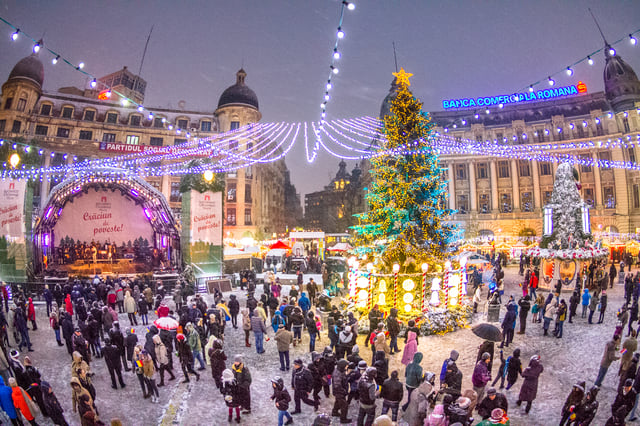
Christmas market in Bucharest
There are 12 non-working public holidays, including the Great Union Day, celebrated on 1 December in commemoration of the 1918 union of Transylvania with Romania.[406] Winter holidays include the Christmas festivities and the New Year during which, various unique folklore dances and games are common: plugușorul, sorcova, ursul, and capra.[407][408] The traditional Romanian dress that otherwise has largely fallen out of use during the 20th century, is a popular ceremonial vestment worn on these festivities, especially in the rural areas.[409] Sacrifices of live pigs during Christmas and lambs during Easter has required a special derogation from EU law after 2007.[410] During Easter, painted eggs are very common, while on 1 March features mărțișor gifting, a tradition likely of Thracian origin.[411]
Romanian cuisine has been influenced by Austrian and German cuisine (especially in the historical regions that had been formerly administered by the Habsburg Monarchy), but also shares some similarities with other cuisines in the Balkan region such as the Greek, Bulgarian, or Serbian cuisine.[412] Ciorbă includes a wide range of sour soups, while mititei, mămăligă (similar to polenta), and sarmale are featured commonly in main courses.[413]
Pork, chicken, and beef are the preferred types of meat, but lamb and fish are also quite popular.[414] [415] Certain traditional recipes are made in direct connection with the holidays: chiftele, tobă and tochitura at Christmas; drob, pască and cozonac at Easter and other Romanian holidays.[416] Țuică is a strong plum brandy reaching a 70% alcohol content which is the country's traditional alcoholic beverage, taking as much as 75% of the national crop (Romania is one of the largest plum producers in the world).[417][418] Traditional alcoholic beverages also include wine, rachiu, palincă and vișinată, but beer consumption has increased dramatically over the recent years.[419]
Sports
The governing body is the Romanian Football Federation, which belongs to UEFA. The Romania national football team played its first match in 1922 and is one of only four national teams to have taken part in the first three FIFA World Cups, the other three being Brazil, France, and Belgium. Overall, it has played in seven World Cups and had its most successful period during the 1990s, when it reached the quarterfinals of the 1994 FIFA World Cup, being eventually ranked third by FIFA in 1997.[421]
The core player of this golden generation was Gheorghe Hagi, who was nicknamed "Maradona of the Carpathians."[422] Other successful players include the European Golden Shoe winners Dudu Georgescu, Dorin Mateuț and Rodion Cămătaru, Nicolae Dobrin,[423] Ilie Balaci,[424] Florea Dumitrache,[425] Mihai Mocanu,[426] Michael Klein,[427] Mircea Rednic,[427] Cornel Dinu,[425] Mircea Lucescu,[428] Costică Ștefănescu,[429] Liță Dumitru,[430] Lajos Sătmăreanu,[431] Ștefan Sameș,[432] Ladislau Bölöni,[433] Anghel Iordănescu,[434] Miodrag Belodedici,[435] Helmuth Duckadam,[436] Marius Lăcătuș,[427] Victor Pițurcă[437] and many others, and most recently Gheorghe Popescu,[438] Florin Răducioiu,[439] Dorinel Munteanu,[440] Dan Petrescu,[441] Adrian Mutu,[442] Cristian Chivu,[442] or Cosmin Contra.[442] The Romanian national team also reached the quarterfinals of the UEFA European Championship three times. Romania's home ground is the Arena Națională in Bucharest.
The most successful club is Steaua București, who were the first Eastern European team to win the Champions League in 1986, and were runners-up in 1989.[443] They were also Europa League semi-finalists in 2006.[444] Dinamo București reached the Champions League semi-final in 1984 and the Cup Winners' Cup semi-final in 1990.[445] Other important Romanian football clubs are Rapid București,[446] UTA Arad,[447] Universitatea Craiova,[448] Petrolul Ploiești,[449] CFR Cluj,[450] Astra Giurgiu,[451] and Viitorul Constanța.[452]
Tennis is the second most popular sport.[453] Romania reached the Davis Cup finals three times (1969, 1971, 1972).[454] In singles, Ilie Năstase was the first year-end World No. 1 in the ATP Rankings in 1973, winning several Grand Slam titles. Also Virginia Ruzici won the French Open in 1978, and was runner-up in 1980, Simona Halep won the French Open in 2018 and Wimbledon in 2019 after losing her first three Grand Slam finals. She has ended 2017 and 2018 as WTA's World No. 1. And Horia Tecău won in doubles three Grand Slams and the ATP Finals final. He was World No. 2 in 2015.[455]
Popular individual sports include combat sports,[453] martial arts[453] and swimming.[453] In professional boxing, Romania has produced many world champions across the weight divisions internationally recognised by the governing bodies. World champions include Lucian Bute, Leonard Dorin Doroftei, Adrian Diaconu and Michael Loewe.[457] Another popular combat sport is professional kickboxing, and produced prominent names, including Daniel Ghiță,[458] and Benjamin Adegbuyi.[459]
Romania participated in the Olympic Games for the first time in 1900 and has taken part in 21 of the 28 summer games. It has been one of the more successful countries at the Summer Olympic Games, with a total of 307 medals won throughout the years, of which 89 gold ones, ranking 15th overall, and second of the nations that have never hosted the game. It participated at the 1984 Summer Olympics in Los Angeles and finished second in gold medals (20) and third in total medal count (53).
Almost a quarter of all the medals and 25 of the gold ones were won in gymnastics, with Olympic and sport icon Nadia Comăneci becoming the first gymnast ever to score a perfect ten in an Olympic event at the 1976 Summer Olympics.[460] Romanian competitors have won gold medals in other Olympic sports: rowing, athletics, canoeing, wrestling, shooting, fencing, swimming, weightlifting, boxing, and judo.
See also
Index of Romania-related articles
Outline of Romania
Romania – Wikipedia book

